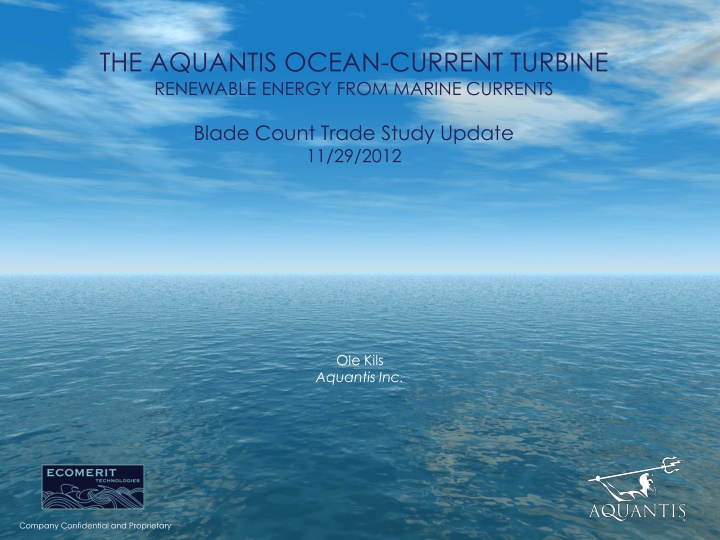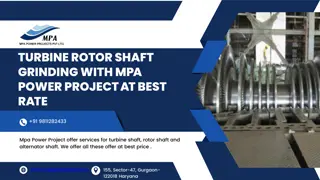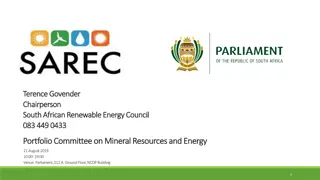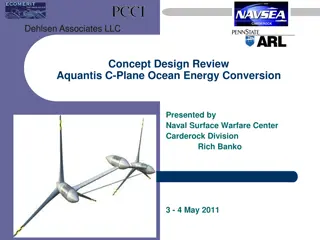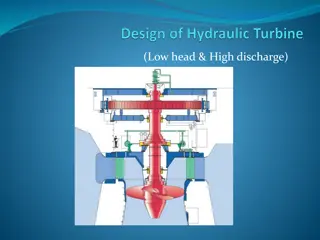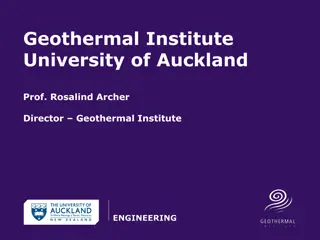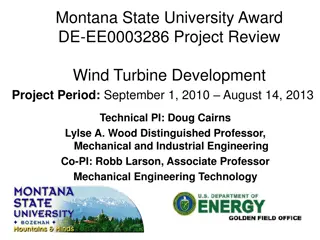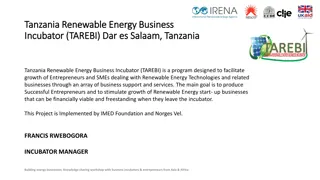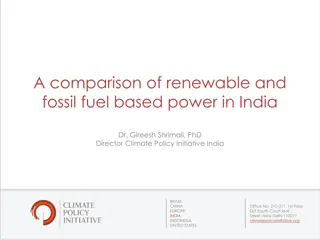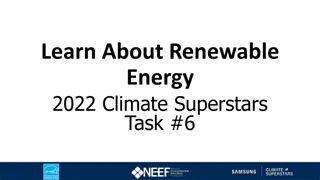Aquantis Ocean Current Turbine Renewable Energy Analysis
An update on a trade study regarding blade count for Aquantis ocean current turbine, discussing ideal hydrodynamic and structural models, calculation approaches, and preliminary results. The study explores the effect of thickness-to-chord ratio on rotor section weight and spar thickness for two- and three-bladed configurations. Findings suggest challenges in building a three-bladed configuration below a certain T/C ratio due to spar intersections.
Download Presentation

Please find below an Image/Link to download the presentation.
The content on the website is provided AS IS for your information and personal use only. It may not be sold, licensed, or shared on other websites without obtaining consent from the author.If you encounter any issues during the download, it is possible that the publisher has removed the file from their server.
You are allowed to download the files provided on this website for personal or commercial use, subject to the condition that they are used lawfully. All files are the property of their respective owners.
The content on the website is provided AS IS for your information and personal use only. It may not be sold, licensed, or shared on other websites without obtaining consent from the author.
E N D
Presentation Transcript
THE AQUANTIS OCEAN-CURRENT TURBINE RENEWABLE ENERGY FROM MARINE CURRENTS Blade Count Trade Study Update 11/29/2012 Ole Kils Aquantis Inc. Company Confidential and Proprietary Company Confidential and Proprietary October 18-19, 2011
Idealized Hydrodynamic Model Basic hydrodynamic assumptions of 2- and 3-bladed rotors: Equal TSR Equal rotor diameter Equal solidity Equal thickness distribution (thickness as % chord) Equal rated power Equal torque This is assumed to give the following blade properties for a three-blade rotor vs. a two- blade-rotor: 2/3 sectional chord along with equal thickness = 2/3 sectional loading along with equal diameter = 2/3 thickness 2/3 sectional moment Volume ratio of this type of 2-bladed rotor is 1.5 times the three-bladed rotor Company Confidential and Proprietary October 18-19, 2011
Idealized Parametric Structural Model 1. Idealize blade section as simple sandwich beam UD spars as facings Syntactic foam as core Assume relationship between airfoil and ideal beam Beam height ~ .85 AF thickness Beam width ~ .6 AF chord Approximate loading/sizing relevant to 2-bladed rotor configuration At ~10m span, ~2.35m chord. Assume baseline of 25% thick airfoil at 10m span. Assume 1m segment length for weight/displacement estimates. My at 10m span ~5450 kN-m. Apply hydrodynamic scaling factors with constant solidity assumption for 3 bladed configuration 2/3 chord with equal t/c yields 2/3 thickness. 2/3 pressure yields 2/3 moment. Assume other relevant material properties Modulus of UD glass and foam. Densities of UD glass, foam and saltwater Maximum allowable stress of UD glass (based on ARL strain limit). 2. 3. 4. 5. Company Confidential and Proprietary October 18-19, 2011
Calculation approach 1. Two variables were investigated: % thickness at given chord and moment vs. rotor section wet weight and spar thickness. Loading intensity at given 35% t/c vs. rotor section wet weight and spar thickness. Each configuration sets geometric or loading parameters and solves for spar cap thickness at design stress in the spars. 2. Company Confidential and Proprietary October 18-19, 2011
Preliminary Results Effect of T/C % Thickness at given chord and moment vs. rotor section wet weight and spar thickness Two blade rotor is more buoyant at all section thicknesses. Three bladed configuration will not be possible to build at foils below 35% T/C for given moment. Spars intersect which is consistent with FEA results of 3-bladed rotor (25% thick foil) Company Confidential and Proprietary October 18-19, 2011
Preliminary Results Effect of T/C cont. Three bladed config. will not be possible to build at foils below 35% T/C for given moment as spars intersect Preliminary FEA showed extremely heavy blade for 3-bladed configuration. 10m span blade has 25% thick airfoil. Case2 Latest Design 3blade circular Hub Case3 Possibility study 2blade circular Hub Number of blade blade diameter Output Blade Fixation Performance Rotation speed AEP Pumps Blade Wet weight Glass Syntactic Foam Root Diameter Hub Wet Weight Specific Torque Braking Torque Root-flap moment Root Stress 3 2 47.5 1300 47.5 1300 Barrel Nut +3-4%(Cp=0.40) 5.6rpm 7,544MW hrs/yr CBM6000 2 +470 kg sink 48,580 kg 42,200 kg 2.3 Meters +5,020 kg sink 11,589N m/bar 4,064kN m 8,613kN m 10,000 kN/m^2 E-glass/Epoxy $2,160,469 $1,392,197 8.9 /kw hr Barrel Nut 5.6rpm 7,544MW hrs/yr CBM6000 2 -12,110 kg float 19,600 kg 52,120 kg 2.3 Meters +5,020 kg sink 12,000N m/bar? 4,100kN m 12,773 kN m 33,000 kN/m^2 E-glass/Epoxy SPECS loading Material material of blade spar Prototype turbine cost Production turbine cost COE Cost Company Confidential and Proprietary October 18-19, 2011
Preliminary Results Effect of Loading Intensity Loading intensity at given 35% t/c vs. rotor section wet weight and spar thickness To evaluate effect on loading intensity, a constant 35% T/C was assumed and the assumed moment was reduced incrementally. Two bladed rotor is more buoyant at all loading intensities At very low moments, the model does not converge since all of the load is carried by the foam alone. Company Confidential and Proprietary October 18-19, 2011
Take-Away & Next Steps For the given assumptions, a two-bladed rotor is more buoyant in all conditions investigated. Next Steps: Evaluate impact of sectional cost along with wet weight Cross-check hydrodynamic assumptions and their effect on system efficiency/power production. Check stress on foam. Assumed to be non-issue since modulus is dominated by spar. Expand model to include more accurate section calculator and be able to include multiple sections to begin thickness optimization studies Company Confidential and Proprietary October 18-19, 2011
Calculation Assumptions t c C b M Chord Spar Cap Width Moment [m] [m] [n-m] 2.35 1.41 hc ho 5.45E+06 EUD EC s(max) L Modulus of Sparcap [Pa] 3.98E+10 Modulus of Core [Pa] 3.79E+09 Max Stress in Sparcap Section Length [Pa] [m] 1.15E+08 1 [kg/m3] s c w UD(max) s(allow) Allowable stress in UD Moment/Chord Ratio Density of sparcap 1920 b [kg/m3] Density of core 673 [kg/m3] Density of Seawater 1029 ? 3 ? 3) ?????= 12( ? Max allow design strain UD [-] [Pa] 2.90E-03 1.15E+08 2.32E+06 ? 3) ?????= 12( ? ?( 0 2)(???) ?????+ ???? ????? (???)= ????? (?????)= ??? ?????? Company Confidential and Proprietary October 18-19, 2011
Blade Element Calculation Company Confidential and Proprietary October 18-19, 2011
